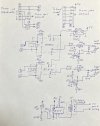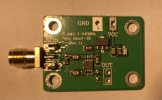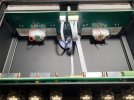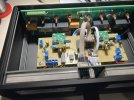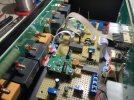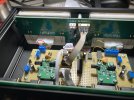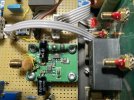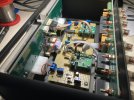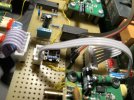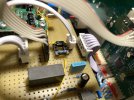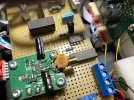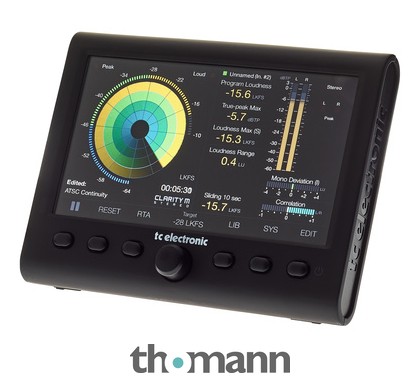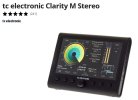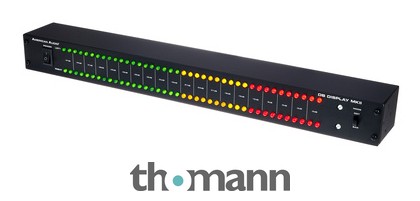This is a review and measurements of the Fosi Audio LC30 Speaker and amplifier switcher plus "power" meters. It was sent to me by the company and costs US $150.
View attachment 396215
As you see, this is a gorgeous unit, sporting prettier meters than a lot of what vintage audio gear used to have. I always considered a meter with flat line markings as cooler.

Both the case and switchgear have a higher quality feel than what I expected. Hitting the selector buttons causes reassuring relay clicks internally. The on/off switch doubles as 3 steps of back light plus off. The gain control has wide range and seems to work better than some of the others I have tested.
The unit is powered by a USB-C connector:
View attachment 396216
You have a choice of two amplifiers and two speakers.
I spent a few minutes to see if the meters show the correct power wattage and they are hopelessly wrong. I would calibrate my amplifier output to a wattage displayed on the meter but when I changed it, the amount of change on the display was wildly different. Contacted Fosi to see if there is an impedance they calibrated to and the answer was: it is not calibrated to anything. It is just for fun.
And fun it is to watch those beautiful meters move. Sensitivity seems good with decent speed.
Fosi Audio LC-30 Measurements
I spent two days trying to measure the impact of LC30 on amplifier performance. I used the Purifi reference design amp to drive the LC30. As I had predicted and feared, the Purifi performance is so good that even slightest change in the impedance of its speaker connection causes third harmonic distortion (seen below). I bought more connectors and built new short speaker cables. I tightened and tightened the connections. Swapped wires and ran a bunch of experiments. But at the end, the impact could not be avoided:
View attachment 396218
There is a dashed blue line which shows the performance of Purifi amp direct. The red mark is the impact of LC30 if you use it as a switcher by routing the speaker output through it. The so called "VCR" (Voltage Coefficient Resistance) shows up more and more as power increases due to resistance variations based on voltage applied. I tried the Topping B100 with same effect. Then I realized that you don't need to use the unit as a switcher. My speaker connectors have a rear banana jack (i.e. they can pass the signal through) so I connected that to LC30. With speaker cables now remaining on the amplifier, we get the performance in green that is overlaid on dashed blue, indicating no impact.
Notice how the noise level is not impacted at all despite the extra cables even in switched mode (the graph before 10 watts). So the issue is only distortion. I am using locking banana connectors above and still registered an impact. If you use anything else, expect a bigger hit. In one case, the connector was a bit less tight and I registered massive distortion and half as much power! So if you are going to use it as a switcher, with a high performance amp, you really need to go the extra mile to get an extra tight connection all around (connector and wire to connector).
Now, if you don't have such a high performance amplifier, then the issue is much less significant to the point of not mattering. Here is LC30 as a switcher in the output of Fosi's own
ZA3 amplifier:
View attachment 396220
As you see there is no performance hit even though I have all the extra cables and connectors. Also, some amplifiers will be less impacted by extra connections and cables.
For kicks, I also ran a crosstalk test with Purifi using LC-30 as a switcher:
View attachment 396221
But note that I did not make an attempt to separate my jumper speaker cables so some of this may be due to that.
Given the passive way you can connect the LC30, i.e., not using it as a switcher, I don't see a reason to run other tests.
Conclusions
The LC30 from Fosi brings us a high quality fun meters with switching ability. If you just want dancing meters, I suggest tapping from the amplifier speaker binging to LC30 and not routing your signal through it. That's the way I would use it. If you are going to use it as an AB switch, you should invest in proper set of short cables. Be careful for any AB quality tests as there can be an audible impact here if utmost attention is not paid to wiring (no fault of this unit but in general).
And oh, don't try to use it as a power meter. It is not for that.
The build quality is excellent and the unit is one of the most beautiful of its kind.
I am going to recommend the Fosi LC30 meter and speaker/amplifier switcher for fun factor.
------------
As always, questions, comments, recommendations, etc. are welcome.
Any
donations are much appreciated using
: https://www.audiosciencereview.com/forum/index.php?threads/how-to-support-audio-science-review.8150/


